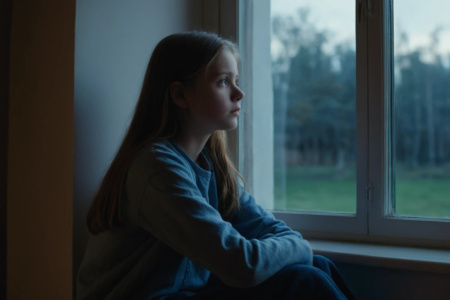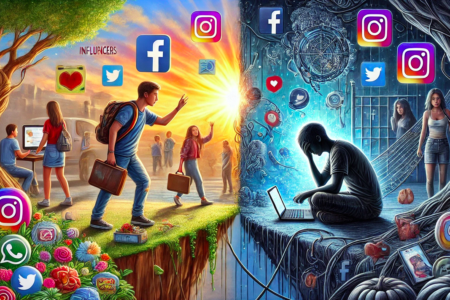In Part 1, we opened the door to understanding mental illness by challenging stigma, exploring its impact, and urging early awareness. Now, in Part 2, we step deeper into the world of mental health — exploring the types of mental illnesses, their hidden presence in daily life, and the critical need for treatment and support. Each story of mental illness is unique, yet many share similar patterns that often go unnoticed. Understanding these nuances can help us become more empathetic, informed, and supportive as a society. Mental illnesses are not one-size-fits-all. They range from mild disruptions in mood or thinking to severe conditions that drastically impact everyday functioning. Broadly, mental disorders fall into categories like mood disorders, anxiety disorders, psychotic disorders, eating disorders, and personality disorders. Among the most common is depression, which can bring overwhelming feelings of sadness, fatigue, hopelessness, and even physical pain. Then there’s anxiety, which is more than just nervousness — it’s a persistent fear or dread that can make even simple tasks feel impossible. Bipolar disorder causes intense mood swings, from emotional highs (mania) to crushing lows (depression), while schizophrenia involves hallucinations, delusions, and a distorted sense of reality. Obsessive-compulsive disorder (OCD) and post-traumatic stress disorder (PTSD) also fall into this complex web, each with its own triggers, symptoms, and challenges. These conditions don’t always show themselves clearly. In fact, mental illness is often hidden in plain sight. A student who is always anxious about failure, a colleague who seems unusually withdrawn, or a loved one who jokes about being tired all the time — these may be quiet cries for help. Unfortunately, our fast-paced lifestyles and societal expectations can discourage people from pausing to acknowledge these signs. We’re taught to “keep going,” to “stay strong,” to “not overthink” — phrases that, while well-intentioned, often invalidate the very real struggles people face internally. Adding to this complexity is the influence of society and culture on how mental illness is viewed. In many cultures, mental health remains a taboo subject. Admitting to a mental health condition is often equated with being “weak” or “unstable,” making individuals reluctant to seek help. Some families may deny the presence of a disorder altogether, dismissing it as a phase, laziness, or drama. In workplaces, the pressure to appear “professional” often discourages people from speaking up about burnout or emotional exhaustion. This silence and shame can delay treatment, worsen symptoms, and sometimes lead to tragic outcomes. But here’s what we must remember — help is available, and healing is possible. Treatment options for mental illness are more diverse and accessible than ever. These include therapy, counseling, medication, support groups, lifestyle changes, and more recently, online mental health platforms. Therapists and mental health professionals are trained to create safe, non-judgmental spaces where individuals can explore their thoughts and emotions. Contrary to popular belief, therapy is not just for people in crisis — it’s for anyone who wants to understand themselves better, improve coping strategies, and live a more balanced life. The journey to recovery may not be linear. There may be relapses, moments of doubt, and emotional setbacks. But with the right support system — friends who listen, families that understand, workplaces that care, and professionals who guide — it becomes easier to manage and live fully. Mental illness doesn’t have to define who someone is; it is simply one part of their human experience. In the next part of this series, we will focus on how you can support someone living with mental illness — what to say, what not to say, how to truly be there, and why even small acts of kindness can be life-changing. We’ll also explore how to build a mentally healthy environment at home, in schools, and at workplaces. Because the fight against mental illness isn’t just personal — it’s collective. We often wonder what to do when someone we care about is struggling — Do I say something? Should I give them space? What if I make it worse? These questions can feel overwhelming, and many of us stay silent out of fear of saying the wrong thing. But silence can sometimes speak louder than words. In Part 3, we’ll unlock the emotional toolkit everyone needs — how to offer real support, how to be a safe space, and how your words, actions, or even quiet presence might be the one thing that changes someone’s life. What does it truly mean to “be there” for someone battling a storm you can’t see? The answers may surprise you. So keep reading FORAMZ.
In a country as young as India—where over 65% of the population is under 35—youth should symbolize energy, innovation, and the bright future of a nation. Intoxication is the problem. Yet, for many, this phase of life turns into a desperate chase for survival, acceptance, and shortcuts to success. When jobs are scarce, dreams are expensive, and role models are replaced by influencers flaunting luxury, many young minds begin to believe that “easy money” is not just possible, but necessary. This is how the dangerous path of drug dealing becomes an illusion of hope. The Rise of the Young Dealers Meet Aditya. He’s 22, an engineering student, with dreams typical of his generation—an iPhone, a Bullet motorcycle, and a trip to Goa. At home, his mother struggles with high blood pressure, and his father is jobless. College fees are overdue, phone EMIs pile up, and there’s no safety net to fall back on. One day, a college friend introduces him to a “job”—selling MDMA. The promise? ₹5000 in a single day. No resumes, no degrees, no office—just money. Tempted and desperate, Aditya agrees. In his mind, it’s temporary. In reality, it’s the beginning of a nightmare. When Dreams Turn Toxic India’s National Crime Records Bureau (NCRB) reports a disturbing trend: a sharp rise in drug-related offenses among young men aged 18 to 25. Police reports from cities like Kochi suggest that nearly 60% of those arrested in drug cases are college students. Most of them are lured into the trade with two things—money and misdirected dreams. The problem isn’t limited to the act of selling drugs. Many young dealers eventually become users themselves. What starts as a source of income quickly becomes a trap. They begin to depend on the very poison they peddle. In trying to fund their aspirations, they end up eroding their future. A Symptom of a Larger Problem We often ask: Is the dealer to blame? Or is it the system that failed them? Youth today are growing up in an environment that emphasizes performance over patience, status over substance, and consumption over character. They are taught to score marks, follow trends, and upgrade constantly—phones, lifestyles, ambitions. But nobody teaches them how to struggle with dignity, to persevere without shortcuts, or to live with less while dreaming of more. Young men like Sameer—middle-class, hard-working, and helpless—sometimes turn to selling drugs to pay for a parent’s medical bills. Society may call them criminals, but their actions are often rooted in desperation, not evil. The Size of the Crisis India’s drug crisis is massive. Over 250 million Indians have tried some form of narcotics. Around 20 million inject drugs, risking HIV and other serious infections. The drug market in India is estimated to be worth over ₹1 lakh crore annually. But the real cost? It’s paid in shattered dreams, broken families, and a generation slowly drifting into darkness. Why It Matters This issue isn’t just about crime or addiction. It’s about lost potential. Every young person drawn into this trade is someone who could have been a builder of the nation—a teacher, engineer, artist, or entrepreneur. Instead, they become part of a black market that feeds off their vulnerability. What’s worse, many of them go unnoticed. They aren’t wearing tattered clothes or sleeping on sidewalks. They are in your classrooms, your metros, your hostels. Smiling on Instagram, and suffering in silence. The Way Forward There is no magic wand to fix this. But there is a solution—and it starts with awareness, empathy, and systemic change. A Message to the Youth If you’re young and reading this, know this: Quick money isn’t wealth, it’s debt in disguise. Sooner or later, it will come knocking—with interest. The job you take today, the choices you make—determine not just your income, but your integrity. There is pride in patience. There is beauty in struggle. And there is always a better way. Let us not allow the fire of our youth to be extinguished in the smoke of narcotics. Let’s ensure our dreams are earned, not sold. Because the future of a nation is not built in drug dens—but in the hearts and hopes of its young citizens. Keep Reading Foramz for your daily dose of moral support. Listen this blog on our podcast channel Social Republic.
Mental illness is one of the most misunderstood and overlooked health issues in society today. Despite growing conversations around mental health, many people still shy away from discussing their struggles, fearing judgment or misunderstanding. In a world that often prioritizes physical health and outward success, the inner battles people face remain hidden. But the truth is, mental health is just as important as physical health, and it’s time we break the silence surrounding it. Mental illness refers to a range of mental health conditions that affect mood, thinking, and behavior. These include common disorders like depression and anxiety, as well as more complex conditions such as bipolar disorder, schizophrenia, and post-traumatic stress disorder (PTSD). Each individual’s experience with mental illness is unique, with some needing short-term support, while others may require lifelong care and understanding. What’s important to remember is that mental illness is not a choice, a phase, or a weakness — it is a legitimate health condition that deserves compassion and proper treatment. The need to address mental health has never been more urgent. According to the World Health Organization, one in every eight people globally is living with a mental disorder. This number has been rising steadily, especially in the aftermath of the COVID-19 pandemic, which brought with it a wave of anxiety, loneliness, and emotional exhaustion. Children, teenagers, working professionals, and even the elderly — no age group has been spared. Unfortunately, even with such alarming statistics, awareness and access to help remain limited, and societal stigma continues to silence those who need support the most. Recognizing the signs of mental illness is the first step toward healing. Warning signs can include persistent sadness, withdrawal from social activities, drastic mood changes, sleep disturbances, overwhelming anxiety or fear, and trouble concentrating. In more serious cases, individuals may even experience thoughts of self-harm or suicide. These signs should never be ignored or brushed aside as “just a bad day” or “attention-seeking.” Just like we rush to help someone with a physical injury, the same urgency must apply to mental health crises. Perhaps the most harmful myth is that mental illness reflects personal weakness or failure. Nothing could be further from the truth. Mental health conditions often arise due to a complex mix of genetics, environmental factors, trauma, and brain chemistry. No one chooses to struggle, just like no one chooses to fall physically ill. What people battling mental illness need is not pity or advice, but empathy, understanding, and support. They need safe spaces to open up without fear of being judged. Mental illness doesn’t always look the way we expect it to. Sometimes it wears a smile in public and cries behind closed doors. It can be hidden in high achievers, busy parents, quiet teenagers, or even the friend who’s always making everyone laugh. This invisibility is what makes awareness so crucial because people often suffer in silence, even when surrounded by others. In the next part of this series, we’ll uncover how these hidden struggles manifest, the different forms they take, and why understanding them is key to creating a more compassionate and mentally healthy society. As we begin to peel back the layers of what mental illness truly means, one thing becomes clear — there’s so much more beneath the surface. Why do certain disorders go undiagnosed for years? What roles do culture, upbringing, and media play in shaping our beliefs about mental health? And most importantly, what does healing really look like in today’s fast-paced, hyperconnected world? In Part 2, we’ll dive deeper into the types of mental illnesses, how they silently affect daily life, and why seeking help is both brave and necessary. Stay with us — the conversation is just getting started. For more interesting content, keep reading FORAMZ.
In the previous blog we witnessed how the problem of student loans is a growing problem in recent times. The instance of Stewart’s aspiration to pursue studies at Texas University was mentioned in the previous blog. Texas University seemed like a beaming light in his life until he was hit by reality like a truck. The more he contemplated the $31,572 fee, the more his chest felt heavy. He was not single in this instance. This is the plight of thousands of students dreaming of becoming millionaires and experiencing the American Dream expecting an improved quality of life. However, that is hardly the case. If you have high generational money then only it is possible to make it in foreign countries. At a recent event, one of the Canadian students made mention of the idea of studying overseas and how all things are pricier and make one feel lonely, disconnected, and way down deep in the belly of student loans.This proves that this is not just an imagined example of Stewart but rather an experience endured by students in overseas countries. Stewart’s aspiration to study at Texas University seemed like a beacon of hope in his life—until reality struck him like a tempest. The more he considered the $31,572 tuition, the more his chest weighed him down. He was not alone in this; his friends were also trapped in the same web of fear, weighed down by the burden of student debt hanging over their lives. Reality Strikes Hard The thrill of the university application later became restless nights for Stewart. He would stay up all day scouring sites for scholarships, grants, and part-time employment. However, each solution proved to be but a drop of water in a sea compared to the whopping fee of tuition as well as upkeep. His parents were eager to assist him but realized that this would prove burdensome to them expending the amount of money on schooling was like shooting in the dark. His peers even though financially better placed, were not also at ease. They had a concern nagging them that their parents’ massive investment in their studies would be a debt burden if they could not live up to the expectations of their academic course. His friends, though better off financially, weren’t happy either. They were afraid that their parents’ investment in their education would turn into a debt trap if they didn’t live up to expectations. The pressure of proving themselves oppressed them, and the aspiration of studying abroad became more stressful than thrilling. Mental Pressure Increases With passing days, the pressure began to set in for Stewart. His grades must be spotless, his extracurriculars, and his statement clear—because one rejection would cost him everything. The prospect of signing a huge student loan was horrifying. The tales of graduates working years to pay back their loans unsettled him. Would he be paying off debt for half his career? Would he ever be able to afford a home or have a family? The stress wasn’t monetary only—it was psychological, as well. His parents had always been his supporters, and he did not want to disappoint them. The burden of responsibilities and the ambiguity of the future started getting into his head. A Crossroads Moment One night, sitting by himself with his computer, Stewart read an article about students who had taken non-traditional routes—online schooling, community college transfers, or attending schools in countries where tuition was lower. It made him wonder: was there another option? Could he still be successful without being overwhelmed by debt? Stewart knew he had tough decisions ahead. Should he follow through with Texas University and risk financial burden? Or should he explore cheaper education routes? His path was just starting, but one thing was certain—student loans weren’t simply a matter of money; they defined the whole future of an individual’s life. This is Foramz, and in the following segment, we will discuss the decisions that Stewart makes and how they redefine the notion of success for him. Read more Foramz for your daily dose of moral support.
The struggles of the transgender youth are not mere individual struggles, but a symbol of the collective responsibility we bear as a society. Each of these stories of hurt, rejection, and struggles to define one’s self is an image of the collective responsibility we bear as a society. The Journey toward acceptance and inclusion is not solitary. The journey toward acceptance and inclusion is not a solitary one; it requires empathy, understanding, and a commitment to change. Today, let’s delve deeper into how we can continue to uplift transgender youth and ensure they feel like they truly belong in this world. The Power of Representation: Seeing Yourself in the World Representation counts. For transgender youth, watching individuals like them in the media, in politics, in sports, and in daily life can be transformative. It’s a strong message: You are not alone. Your identity is valid. You matter. Think of being a teenager grappling with your identity, looking through social media or watching television, and never seeing anyone like you. Lack of representation may be a deafening erasure, an affirmation of the anxiety that the world doesn’t want you. But when transgender folks are honored for all their queerness—when their lives are told with candor and integrity—it makes for a ripple of hope and potential. We must insist and fashioning welcoming spaces in which transgender voices are heard. It means we must stand behind transgender artists, writers, and creators. It means we must fight for respectful and accurate representations of transgender individuals in the media. Community Support: Creating Networks of Belonging While family and school are essential pillars of support, the wider community also has a crucial role in influencing the lives of transgender youth. While family and school are essential pillars of support, the wider community also has a crucial role. But support from the community does not have to exist only in LGBTQ+ environments. Neighbors, coworkers, friends, and even strangers- all can change the world. Small and gracious acts such as respecting someone’s pronouns or challenging transphobic comments, can be deeply impactful. When we appear to or transgender children, we communicate in no uncertain terms: You are not alone. We see you and we stand with you, and we are here for you. Education and Awareness: Breaking Down Barriers Ignorance is frequently the source of prejudice. Most of the difficulties faced by transgender young people are based on a lack of Ignorance is usually the origin of prejudice. Most of the issues transgender youth face are due to a lack of knowledge about what it is to be transgender. Learning is a great tool for breaking barriers and creating empathy. Schools, workplaces, and communities need to make education on gender diversity a priority. This involves educating youth on the range of gender identities, the value of honoring pronouns, and the damage of stereotypes and discrimination. It also involves educating educators, healthcare workers, and other professionals to be knowledgeable and affirming allies. But education doesn’t end at institutions—it begins with us. Take the time to learn about transgender issues. Listen to the experiences of transgender people. Challenge your own assumptions and biases. When we educate ourselves, we become better able to create a world where everyone feels respected and valued. The Role of Faith and Spirituality: A Source of Healing, Not Harm For most families, spirituality and faith are a core part of their existence. Sadly, religious doctrine is often used to legitimize rejection or discrimination against transgender teens. However, this doesn’t have to be the way things are. Faith can also be a force for love, compassion, and healing. Faith leaders and communities have a special chance to set an example of acceptance and inclusion. By affirming the inherent value and dignity of every person, regardless of gender identity, they can send a strong message of love and belonging. Most faith traditions already affirm the values of compassion and justice—it’s time to apply those values to transgender youth. The Ripple Effect of Allyship: Small Acts, Big Impact Allyship is not an event—it’s a way of life. It’s about being present, even when it’s hard. It’s about leveraging your privilege to center marginalized voices. It’s about being willing to challenge injustice, even when it’s convenient to remain quiet. Each action of allyship, no matter how small, has the potential to bring about change. Whether it’s calling out someone who misgenders a friend, fighting for inclusive policies at work, or just listening to a transgender young person’s story, these actions accumulate. They have a ripple effect that can change lives and communities. A Call to Action: Be the Change They Need The journey to acceptance is a long one, but it’s worth taking. Every step toward justice—every bit of kindness, every attempt at listening, every challenge to discrimination—gets us one step closer to a society in which transgender kids can survive. We have to be the change they require.We have to be their supporter, their champion, their steadfast ally. We have to build a world where no transgender child ever feels isolated, where every young person is cherished for precisely who they are. This is not only about transgender youth—it’s about all of us. It’s about the world we wish to inhabit: a world in which love wins over hate, compassion conquers prejudice, and every individual has the freedom to be who they truly are. Final Thoughts: A Future of Hope and Belonging The issues transgender youth are confronting are deep, but so is the possibility of transformation. With compassion, empathy, and action, we can have a future in which every child is loved, accepted, and valued. Let’s be part of that change. Let’s hear the testimonies of transgender young people, raise their voices, and join them in their struggle for justice and equality. Let’s create a world where no one has to hide themselves, and everyone can live with dignity and pride. Together, we can transform pain into hope, loneliness into belonging, and dreams into reality. Because every child
Imagine feeling so invisible, so lost, that you begin to question if anyone would even notice if you were gone. For 16-year-old Maya, this was her everyday reality. The constant pressure from school, the overwhelming loneliness, and the haunting feeling of being trapped each day felt like a silent battle. Maya had always been the quiet, creative type, but behind her calm demeanor was a storm she didn’t know how to fight. The pressure from school was suffocating. Her grades were falling, her friends seemed to be moving on with their lives, and her family’s expectations felt like an impossible mountain to climb. Every day, she felt like she was losing herself just a little bit more. It wasn’t just about school. It was the loneliness—the kind of loneliness that doesn’t go away even when you’re surrounded by people. Maya couldn’t talk to her friends because she didn’t know how to explain the suffocating sadness she was feeling. She didn’t want to burden her parents, who were already stressed with their own lives. So, Maya did what many teens do when they feel like no one’s listening: she bottled it all up. It wasn’t until one afternoon, when the weight of it all became too much, that Maya reached a breaking point. She found herself staring at the edge, considering whether it would just be easier to end the pain. The thoughts were loud, persistent, and terrifying. But then, something happened. It was a message. A simple “Hey, you good?” from her best friend, Riya. At first, Maya didn’t know how to respond. She hadn’t been answering calls or texts much, but for some reason, this one felt different. It wasn’t just a “Hey, what’s up?” it was a genuine check-in, an open door that Maya didn’t even realize she needed. Riya wasn’t trying to fix anything and wasn’t offering unsolicited advice. She didn’t even push Maya to talk. She just said, “I’m here for you. Whenever you’re ready to talk, I’ll listen.” A few days later, Maya finally took the first step. She reached out to her school counselor. It wasn’t easy. It took every ounce of courage she had left, but walking into that counselor’s office marked the beginning of her healing. That was the moment things began to shift for Maya. She didn’t open up right away, but that message planted a seed of hope. Someone cared. Someone noticed. Maybe it was worth sticking around to see what could happen next. Over time, therapy helped Maya untangle the mess in her mind. She learned coping mechanisms for the stress, the pressure, and the anxiety. It wasn’t a magic fix some days were still hard but she felt stronger. And through therapy, she discovered something that truly began to save her: her passion for painting. Painting had always been an escape, but Maya never thought of it as something she could rely on for healing. She started sketching again just little things at first, but they gave her a sense of peace. Over time, those little sketches turned into full paintings, each one more vibrant and expressive than the last. She painted her anger, her sadness, and eventually, her joy. Her canvas became a place where she could let it all out with no judgment, no expectations, just her, the brush, and the colors. Maya’s journey wasn’t perfect, but it was hers. She found hope in the smallest of things: a message from a friend, the courage to ask for help, and the power of self-expression through art. And now? Maya knows that even in the darkest times, there is a way back. She’s still learning, still healing, but she no longer feels trapped in a world where there’s no way out. To anyone reading this, remember this: You are never alone. There is always a way through, even when there isn’t. Whether it’s a friend reaching out or a counselor offering guidance sometimes, all it takes is a single step toward hope to change everything. If Maya could find light in the darkness, so can you. Keep reading foramz for your daily dose of emotional support.
In this digital age social influencers have become powerful figures shaping the thoughts, beliefs, and behaviors of young people worldwide. Unlike traditional celebrities, who gained fame through talent and years of experience, influencers are grabbing a hold of the social media platforms like TikTok, YouTube, and Twitter. They create content ranging from lifestyle, fashion, fitness, and entertainment to self-improvement, education, and activism. The name iInfluencer, itself suggests their influence on the world. More specifically, the youth. They have having profound influence over the minds of emerging youth. Some provide very useful information while some gain popularity overnight. But imagine, watching a girl with a perfect hourglass figure, vlogging on Instagram showing her life. As a girl studying in college, if I perceive her, it creates a negative image in the mind. Some might feel that the body standards depicted are the only way to be seen and noticed. This is Foramz and today we will be discussing the Impact of Influencers on Young Minds. The rise of influencer culture has sparked debates on its effects—whether it is empowering the youth by providing them with inspiration and knowledge or negatively shaping their perceptions through unrealistic standards, materialism, and mental health challenges. The human mind, particularly during youth, is highly impressionable. Adolescence and early adulthood are crucial stages of cognitive and emotional development, where individuals seek role models to define their identity and values. In the past, these role models, were often parents, teachers, and historical figures. However, with the rise of social media influencers have taken over as role models for inspiration. Unlike mainstream celebrities, actors, and stars, influencers seem more relatable. They share daily lives, struggles, and personal achievements, creating a sense of authenticity that resonates deeply. The perceived authenticity fosters rust making youth more reliant on the opinions, habits, and lifestyles of influencers. Whether it is following a particular fashion trend adopting a diet or pursuing a certain career path, young people often base their choices on what they see online. It is bound to happen, what we see all the time influences our thoughts and perception of reality. The algorithms on social media seem to know exactly how you feel, be sad, depressed, or happy social media pops up the reel which heightens that emotion. The influence of social media influencers on youth is a double-edged sword. On one hand, influencers can be a force for good, inspiring people to develop skills, adopt healthier habits, and become more aware. On the other hand, they can also contribute to toxic mindsets, unrealistic expectations, and psychological distress. It is all how youth perceive it. You might have faced this one moment when you feel amazing about your body but the other moment you see the life of an influencer following, a keto diet or going to a fancy gym and having a fantastic figure. There goes our mind distracted. Our minds started comparing our bodies with the perceived reality of influencers. The dark side of influencer culture cannot be ignored. One of the most significant issues is the promotion of unrealistic standards—whether it’s beauty, success, or lifestyle. Social media influencers often portray picture-perfect lives, edited to remove flaws and struggles. This creates a false perception of reality, making young people feel inadequate when they compare themselves to these carefully curated images. Materialism and consumerism are also prevalent in influencer culture. Many influencers are always promoting luxury brands, expensive lifestyles, and unattainable beauty standards, which make the youth believe that happiness is tied to wealth and physical appearance. This makes them suffer from low self-esteem, anxiety, and financial irresponsibility as they try to keep up with the trends of influencers. Conclusion: The Need for Critical Awareness Ultimately, the influence of social media influencers is neither entirely good nor entirely bad. The key lies in how we navigate ourselves through this influence. In the next blog, we will discuss how the influencer culture affects the mental health of youth in detail. Keep Reading Foramz for your daily dose of Moral support.
Last week we talked about the issues youth might be facing. The reasons, hurdles, and situations that might have led them to resort to bad habits like vaping and cigarettes. Youth forms a large part of our society, and it’s sad that a large part. of our society is engaged in negative activities. To find a possible solution to this social issue, it is important to address the mental state of the budding minds. We nee to understand their thought process and not judge them based on their bad behavior. In the last blog, we discussed how loneliness is the key reason for the youth’s choice of vaping and smoking. This is Foramz and we will discuss how we can create a positive environment for them and help them foster healthy habits. If you are reading this, and are feeling alone, trust me you are not alone. In this span of age, we call “youth” generally goes through the phase and it is completely normal. Vaping and smoking might feel like a quick escape, but in the long run, it will be beneficial to resort to healthy coping systems. 1. Build Deep and Meaningful Connections Loneliness often comes through a lack of genuine relationships with people loneliness often comes from a lack of genuine relationships rather than just the absence of people around us. One way to counteract this is by actively working on building friendly relationships. Start by reaching out to people you already know, such as family members, classmates, or old friends. A simple message or check-in can catch up on relationships and remind you that you are not alone. Additionally, stepping outside of your comfort zone and engaging in social activities can help. You can join a sports club, or sports teams or enroll in a hobby class that you like. Engaging in activities you like releases oxytocin levels. This will help you connect with like-minded people which will help foster a feeling of belonging. It might sound difficult at first, but consistent effort in socializing helps build familiarity and friendships over time. 2. Develop Emotional Resilience and Self-Awareness Understanding and tipping into your emotions is very crucial. Only you can know the true reason for your sadness. Understanding your emotions and finding healthy ways to process them is crucial in overcoming loneliness. Instead of bottling up emotions or masking them behind harmful habits, try engaging in activities that allow self-expression. Engaging in Journaling, painting, or playing music can be powerful tools for self-reflection and emotional release. Mindfulness and meditation can also help you stay present and reduce negative self-talk, making it easier to accept and navigate feelings of loneliness. Learning to be comfortable with solitude and enjoying your own company is just as important as building relationships with others. Once you learn that you are your best friend nothing else will be able to bind you in its cage. 3. Engage in Physical Activities to Improve Mental Health Exercise has been scientifically proven to boost mental well-being by releasing endorphins, which act as natural mood enhancers. Engaging in sports, yoga, or even daily walks can significantly reduce stress and feelings of loneliness. Physical activity also provides opportunities to meet new people and form social bonds through group workouts, dance classes, or recreational sports leagues. Moreover, focusing on fitness goals can shift your attention away from negative habits like smoking or vaping, replacing them with healthier coping mechanisms. 4. Reduce Social Media Dependency and Increase Real-Life Interactions Social media mostly amplifies loneliness rather than eliminating it, for it creates unhealthy comparisons by setting unrealistic portrayals of people’s lives. Making a huge difference in how you feel is a matter of cutting down on screen time and focusing on real-world connections. Set specific time limits for your social media usage and engage in offline activities like reading, outdoor hobbies, or in-person meetups with friends. Face-to-face contact will help build deeper emotional ties and give one the support often missing in digital interactions. The more present one is in their moment and engaging with the people around them, the less they will feel lonely. 5. Replace Smoking and Vaping with Positive Coping Mechanisms If it has become a habit to vape or smoke, it is imperative to replace those habits with healthy coping mechanisms. Identify what triggers your desire whether due to stress, boredom, or social pressure-and find alternative methods to handle the situation. Manage cravings through deep breathing exercises, sucking on chewing gum, or using a stress ball. Distractions in the form of an instrument, crafting, or gardening can be both distracting and fulfilling. Sometimes, talking with a trusted friend, family member, or counselor may also prove helpful in quitting. There are professional quit-smoking programs and mobile applications that have been designed to monitor progress and maintain motivation. The process of breaking this habit involves more than stopping; it requires replacing the bad habit with more positive and enduring coping strategies. 6. Get Help or Guidance When Needed Loneliness and addictive behavior often become so unmanageable that they can’t be managed by an individual. Talking to a therapist, school counselor, or support group can provide much-needed emotional support to help them through these changes. Professional guidance can offer a personal strategy or coping mechanism best suited to a particular situation. If you find that your loneliness or vaping has been severely impairing your mental health, there is no harm in contacting some helplines or community groups for healing purposes. Surround yourself with positivity and build strong support systems for yourself, as these will really help you during your journey through loneliness and other unhealthy habits. Little by little, you could begin to feel better about how you think, as well as live a more balanced life, through these adjustments. Change takes time, and each step leads you closer to a more satisfied and connected life. For your daily dose of moral support keep reading Foramz.com.
Last week we talked about how loneliness in youth can result in habits of smoking and vaping. To get into the root of the issue it is important to understand what leads to the youth’s attention drifting in the direction of such habits. You might have noticed how vaping and smoking have become common among the youth. Whether it’s at a house party, during a break at school, or even scrolling through social media, it’s everywhere. But have you ever wondered why are we turning to these habits? What is it that we are looking for in that puff of cigarette? It’s not always about looking cool or rebelling. For a lot of people, it’s about filling a void—loneliness, stress, or just trying to feel like we belong somewhere. Let us talk about the reasons one by one. The Weight of Loneliness Loneliness is a word that creeps at us. The feeling is not always obvious, but it’s there, creeping in late at night when we’re mindlessly scrolling through Instagram or TikTok. We see everyone else having fun, going to parties, traveling, and living their best lives. “But what about me?” A question that leaves us feeling lonely or in today’s language FOMO, we experience the fear of missing out. We feel left out like we don’t measure up or “fit in.” It’s a terrible feeling, right? And that’s when the idea of a quick escape—a vape pen or cigarette—starts to look tempting. For a moment, it feels like it takes the edge off, like it’s giving you a break from all the noise in your head but tragically, its adding on to that void. Trying to Fit In We’ve all been there—that moment when you’re hanging out with friends, and someone offers you a vape. You don’t really want to, but saying “no” feels impossible. You don’t want to seem lame or risk being left out. It’s tough because fitting in feels so important, the fear of being alone is so prominent that you take a puff. It’s not always about enjoying it; it’s about belonging, even if just for a moment. The Circle of Expectations Life can be stressful, even for youth. Between school, grades, extracurriculars, and trying to figure out what you want to do with your life, it feels like the weight of the world is on your shoulders. In reality, it is not but the age, the surroundings, and societal pressure make us feel that way, which is completely natural. Add in the pressure to have a happening social life, look good, and keep up with everyone else, and it’s enough to make anyone crack. But vaping or smoking might not be the lifeline you are looking for. Vaping or smoking might feel like a way to take a breather, to calm your nerves. But the truth is, that relief doesn’t last. It’s just a temporary band-aid for a much bigger wound. Family and Emotional Struggles In some cases, the problem starts at home. Maybe your parents are too busy to notice what you’re going through, or maybe they just don’t get it. You feel invisible, like no one really understands or cares. Picking up a vape or a cigarette might feel like a way to take control, to do something for yourself. Or maybe it’s a way to say, “Hey, I’m hurting.” But here’s the thing: you’re not invisible, and people do care, even if it doesn’t feel that way right now. Things do change. The Hold of Marketing Have you ever noticed how vaping is made to look so cool? Flavors like mango, cotton candy, grapes, and mint—they’re not targeting adults; they’re targeting youth. The ads make it seem harmless, even fun and cool. But the reality is that these companies are selling them intentionally by promoting them as a “safer option” than cigarettes, which is totally a myth. Nicotine is one of the main ingredients in vape. It has harmful chemicals which can cause lung diseases and even cancer. The companies, just want your money. And once you’re hooked, it’s hard to stop. That’s how they win. Don’t let them. You’re Not Alone If you’re reading this and somewhere resonate with it don’t worry you are not alone. There are so many people out there who feel the same way you do. The world can be tough, and it’s okay to struggle. What’s important is that you don’t give up on yourself. You are worth more than a vape pen or cigarette. You’re stronger than you think, and you have an entire life to live full of possibilities. Do not let that temporary escape steal that from you. Stay strong, and remember you’ve got this. Here’s the truth: vaping and smoking won’t fix the loneliness, the stress, or the pressure. They might distract you from the pain for a little while, but in the long run, they’ll only make things harder. Addiction, health problems, guilt—none of that is worth it. So in the next week, we will see in detail how can we healthily cope with these emotions. Because you are not alone. Keep Reading Foramz for you daily dose of moral support.









